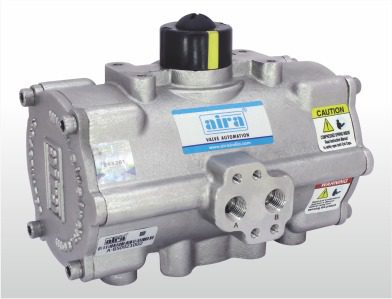A pneumatic rotary actuator is a type of actuator that uses compressed air to produce rotary motion. It is a versatile and compact device that can be used in various applications, from automotive assembly to material handling.
Pneumatic rotary actuators are advantageous because they are relatively low cost, require little maintenance, and are easy to control. When used properly, they can provide reliable and precise motion control.
To get the best out of a pneumatic rotary actuator, it is important to select the right size and type for the application and to maintain the actuator properly.
What is a pneumatic rotary actuator?
A pneumatic rotary actuator is a device that uses compressed air to create torque or rotational force. It consists of a cylindrical chamber filled with compressed air and a piston connected to a rotating shaft. When the piston is forced into the chamber, it pushes against the air, creating torque. The amount of torque created depends on the size of the chamber and the pressure of the air.
Pneumatic rotary actuators are used in various applications, such as opening and closing valves, operating pumps and motors, and moving other objects. They are often used where high forces are required, such as in car brakes and door closers. They are also used in many industrial applications, such as assembly lines and conveyor belts.
How does a pneumatic rotary actuator work?
A pneumatic rotary actuator is a device that uses compressed air to convert energy into rotary motion. It consists of a housing, a piston, and a crankshaft. The housing contains the air chamber, the piston, and the crankshaft. The air chamber is where the compressed air is stored. The piston is connected to the crankshaft and transfers energy from the compressed air to the crankshaft. The crankshaft is connected to the load, typically by a wheel or a gear.
Compressed air flows into the chamber and pushes on the piston when the actuator is turned on. The piston then pushes on the crankshaft, which causes the load to rotate. The torque that the actuator can generate depends on the size of the air chamber, the piston, and the pressure of the compressed air.
What are the applications of a pneumatic rotary actuator?
A pneumatic rotary actuator can be used in a variety of applications. One example is automotive engines, which open and close intake and exhaust valves. Another example is in HVAC systems, where they are used to control dampers and vents. They are also commonly used in industrial machineries, such as conveyor belts, packaging machines, and material handling equipment.
Why is a pneumatic rotary actuator advantageous?
A pneumatic rotary actuator is advantageous because it is a compact, lightweight device that generates high torque. It is also durable and has a long lifetime. Additionally, it is easy to control and can be used in various applications.
How can you get the best out of a pneumatic rotary actuator?
Pneumatic rotary actuators offer several advantages that make them well-suited for various applications. It is important to understand its capabilities and limitations to get the best performance from a pneumatic rotary actuator.
Pneumatic rotary actuators are capable of generating high torques. This makes them well suited for use in applications requiring high forces, such as automotive engines and industrial settings. They are also compact and lightweight, which makes them easy to install and operate. Additionally, pneumatic rotary actuators are durable and have a long lifetime.
To get the best performance from a pneumatic rotary actuator, selecting the right size for the application is important. The required torque can be determined by calculating the load on the actuator shaft. Once the required torque is known, the appropriate-sized actuator can be selected. It is also important to consider the available air pressure, as this will determine the maximum force the actuator can generate.
Pneumatic rotary actuators are easy to control and offer a high degree of precision. However, they are limited by the amount of force they can generate and the speed at which they can operate. When selecting a pneumatic rotary actuator for an application, it is important to consider these limitations to ensure that the actuator will be able to meet the requirements of the application.

